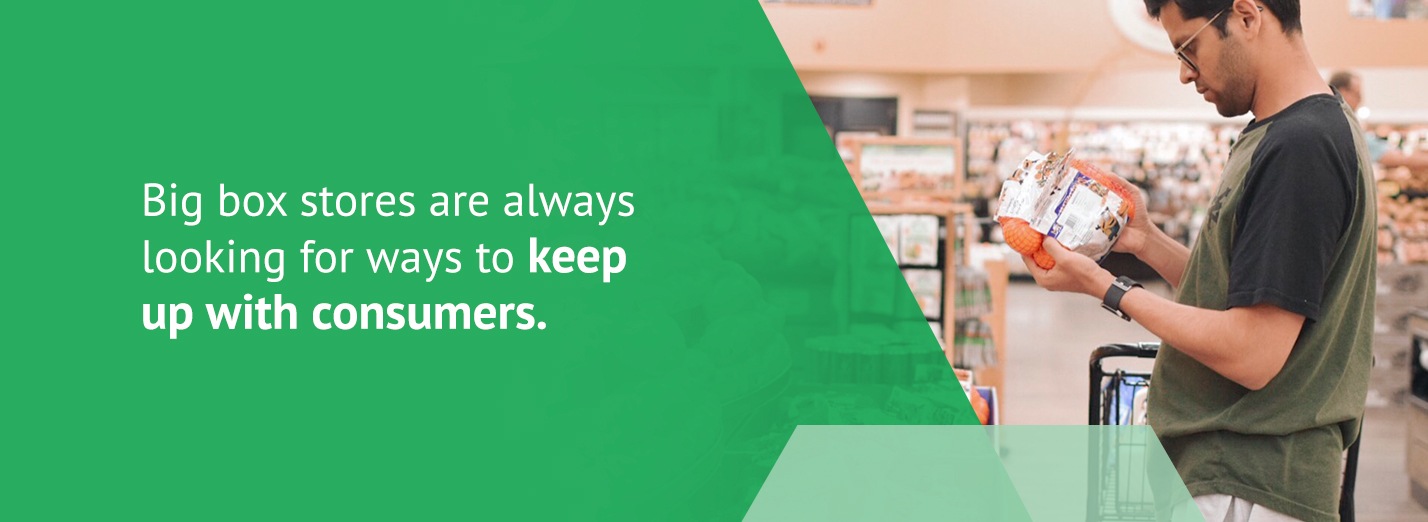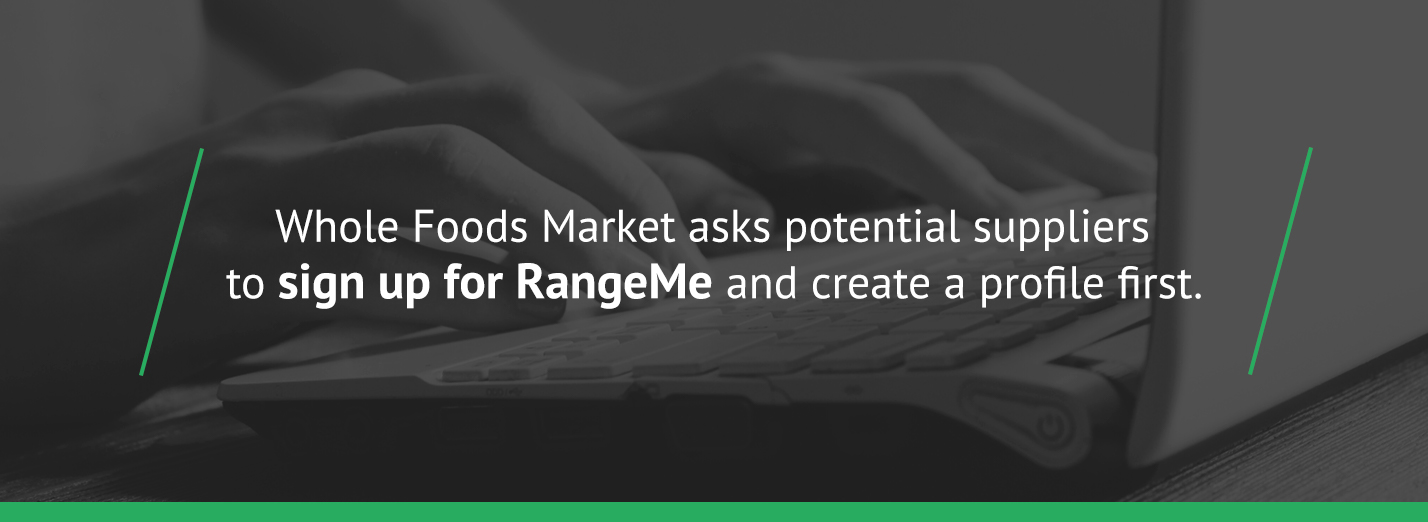Chapter 3: Find the Right Big Box Store for Your Products
Although no two stores are the same, most big box retailers look for ways to keep up with consumers. This includes offering new products that provide value to the customer. If you know what retailers look for in new products, you’ll have an easier time choosing the right big box store for your brand.
It’s also important to consider what you want and how a particular retailer might benefit your company and get your products noticed.
In this chapter, we share tips for selecting a compatible big box store. We also show you what it takes to get your product into Walmart, Target and Whole Foods Market.
How Do Retailers Buy Products?
Retailers frequently add new products to their stores to drive sales, but that doesn’t mean they’ll accept anything. Retailers looking for new products typically consider the following before making a decision:
- Is it consumable? Retailers think about how often customers will stock up on certain items, and consumable goods are those that sell fast and can typically be sold at low prices. For example, customers frequently shop for consumer packaged goods such as food, beverages and cosmetics. These products can consistently bring profit to a store.
- Does it have attractive packaging? Retailers consider if the product’s packaging will help it sell. They want the packaging to catch their customers’ eyes, quickly explain what the product is about and protect the item from damage.
- Is it unique and on-trend? Retailers add new products to keep up with current trends and make customers excited to visit their store. Before they add new inventory, they’ll consider if a product is popular and offers something different. For example, Walmart asks suppliers to compare their products to existing ones and consider if it’s the most “innovative, best quality and at the lowest price.” Walmart also clarifies that they choose products their customers want when they select new items to stock.
- Can it be produced fast? While it’s critical to have a great product that sells, it’s just as important to be able to fill a retailer’s order on time. No matter how much a retailer loves your product, they’ll need to know you can keep up with the demand.
- Is it well-priced? Customers love big box stores for their low prices. A retailer will consider if a product meets their pricing expectations before they welcome a new supplier. Therefore, suppliers must be flexible so retailers can continue to provide great prices for their customers.
Tips for Choosing a Big Box Store
Many different types of big box retailers exist in the United States, from supermarkets to office supply stores. Since it takes time and energy to apply to a big box store, it’s worth narrowing your options to those that best match your product. You’ll also have greater success if you choose a retailer that suits your brand. Here are a few tips for finding a great fit:
- Hit the stores: What’s an easy way to determine the right retailer for you? Hop in your car, head to local big box stores and browse for similar or related products.
- Use your imagination: As you roam the aisles of your possible retailer-to-be, imagine where your product would sit on the shelf or display. Is it easy to envision? If so, take note. If not, consider moving onto a different store.
- Consider your audience: Consider your brand’s audience and where they like to shop. For example, can you see your customers shopping for groceries at a Walmart Supercenter, or do they seem more likely to stock up at Whole Foods Market? Let your audience be your guide.
- Assess your product: Imagine the customers who shop at your chosen big box store and consider how your product will make their lives better.
- Ponder your price: Think about your product’s price and if it’ll meet the store’s needs. Consider how flexible you’re willing to be to work with a particular retailer.
After you have a list of potential retailers, research each one to find out as much as you can. Explore the retailer’s website, check forums to learn from experienced suppliers or contact a local store manager to ask questions.
How to Get Your Product in Walmart
Can you easily picture your products on display at Walmart? Are you prepared to sell your products at reasonable prices? Selling products at Walmart can be a profitable strategy, but it’ll take a few key steps to get your foot in the door. To join the team at Walmart, you’ll need to apply as a supplier. Walmart has several supplier categories, which include:
- Store
- E-commerce
- Marketplace
- Direct import
- Service and non-resale
If you plan to stock your item on the shelves at Walmart, you’ll want to apply under the store category.
Regardless of the type of supplier you wish to be, you’ll need to meet specific standards to qualify. Walmart put together a supplier checklist to help you prepare for the application process. For example, according to the checklist, you’ll need a Data Universal Numbering System (DUNS) number, tax number and product liability insurance. You can read more about Walmart’s minimum requirements on their website.
When you’re ready to apply, you’ll need to follow the instructions for the appropriate supplier category. For instance, if you want to be a store supplier for Walmart, you’ll need to create an account with Walmart’s retail link.
Becoming a supplier for Walmart takes some time, so it’s essential to plan ahead. According to the University of Arkansas, obtaining a DUNS number can take 30 to 60 days. Due to Walmart’s supplier application process, the university recommends food producers begin the process at least one season before they plan to start selling food at Walmart.
If the application process overwhelms you or you want to explore ways to remove some of the competition, there are other approaches you can take to applying as a Walmart supplier. These include:
- Hire a sales rep: A sales representative who has experience working with Walmart can help you successfully pitch your product and make a connection with buyers.
- Explore your Local Purchase Program: Walmart’s Local Purchase Program is a way to sell locally made products. You can contact your local Walmart to discuss your product and find out if they have a Local Purchase Program.
- Be a diverse supplier: Consider if you can be a diverse supplier. Walmart’s Supplier Inclusion Program encourages companies owned and operated by women, minorities, veterans, individuals with disabilities and members of the lesbian, gay, bisexual or transgender community to apply to be a supplier. You can learn more about the program through Walmart’s Supplier Inclusion Handbook.
- Attend an annual Open Call event: Every year, Walmart holds an Open Call event in Bentonville, Arkansas. During this event, entrepreneurs get to meet Walmart buyers face-to-face, build their network and hopefully make a deal. To attend the event, you’ll need to apply a few months in advance.
How to Get Your Product in Target
Target understands its customers exceptionally well and offers trendy items at affordable prices. If you have a product that’ll appeal to Target’s loyal fans, you might consider becoming a supplier.
To start the process, first review Target’s Rules of Use, responsible sourcing programs and Vendor Code of Conduct. Also, know you’ll be required to use an electronic funds transfer if you’re a domestic supplier and electronic data interchange. You’ll also need proof of insurance. If that all works out, you can contact a Target merchandising or sourcing team member.
If the team member selects your product, you’ll get an email invitation to create an account in an online portal. Once you have an account, you’ll need to provide more information about your company to move forward with the approval process.
How to Get Your Product in Whole Foods Market
Whole Foods Market sells natural and organic food, dietary supplements and body care products. Buyers at Whole Foods Market look for unique, high-quality products they can sell at competitive prices. If you want to be a supplier for Whole Foods Market, your product will need to meet specific quality standards.
If you have a one-of-a-kind product that measures up, you’ll need to sign up for RangeMe and create a profile. Your product information on RangeMe will then be sent to the appropriate buyer at Whole Foods Market for review.
To help you get into Whole Foods Market, start with a local store and be sure to study the layout. Know where you’ll stock your product in the store so you can help the buyer picture where you’ll fit in. It also helps to generate excitement about your product before you meet with a buyer by selling your items at a farmers market.
If you need ideas on how to display your product to impress buyers, whether you wish to be a supplier for Whole Foods Market, Walmart, Target or another big box store, we’re ready to help at Creative Displays Now.
Table of Contents
- How to Get Your Product Into Big Box Stores with CDN
- Chapter 1: Why Market Your Products in Big Box Stores?
- Chapter 2: How to Market Your Product to Retailers
- Chapter 3: Find the Right Big Box Store for Your Products
- Chapter 4: How to Approach Retail Stores to Sell Your Product
- Chapter 5: Get Your Products in Stores With Custom Displays



